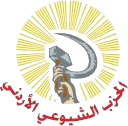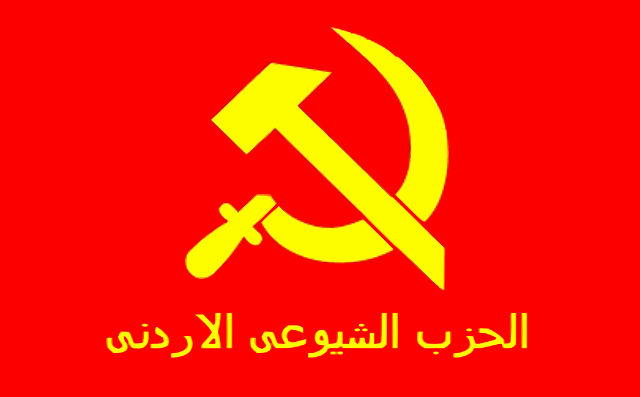More languages
More actions
Jordanian Communist Party الحزب الشیوعی الاردنی | |
|---|---|
 | |
| Abbreviation | JCP |
| Leader | Saud Qubailat |
| Founded | 1948 |
| Headquarters | Amman |
| Newspaper | al-Jamahir |
| Political orientation | Communism |
| International affiliation | IMCWP |
| Party flag | |
 | |
| Part of a series on |
| Communist parties |
|---|
The Jordanian Communist Party (JCP), is a communist party in Jordan.
History
Grew out of the National Liberation League in Palestine. Became the Jordanian Communist Party (JCP) in 1951, after a name change and recognition of Transjordan sovereignty.[1] Experienced many splits throughout its history, which has contributed to the weakness of the Jordanian left.[2] The JCP was forced underground by the Jordanian government in 1957. During the next decade underground, between 1957 and 1967, the JCP experienced an internal division over peaceful versus armed struggle. "Accommodationist" leaders within the JCP (Fahmi Salfiti), opposed the "adventurist tendencies" that had proliferated (really, this "adventurism" reflected a broad mass call for militant, armed struggle) in the aftermath of the Six-Day War. The militant wing of the party, led by Fu'ad Nassar, led a short-lived commando organization within the JCP.[3]
The conservative leadership of the JCP could not maintain its stance against militant mass attitudes, as a "rising radical tide" united both secular/left nationalists and liberation jihadists toward armed struggle.[4] From 1967 to 1970 (culminating in Black September), the JCP was swept in with the wave of Palestinian fedayeen activity, although the JCP remained a rival to the PLO. After the end of Nassar's commando organization, the party participated mainly in the trade union struggle throughout the Jordanian ban on political/partisan activity. PLO factions in Jordan monopolized illegal political struggle until 1970, when the PLO withdrew from Jordan. The DFLP and other PLO activists still in Jordan were the bases of today's Jordanian Democratic People’s Party (HASHD) and Jordanian Democratic Popular Unity Party.[2] Today, the JCP protests against Jordan's normalization with the Zionist Entity.[5] The party perceives the Jordanian masses as integral to the Palestinian struggle and supports Jordanians in the street protesting against the Zionist response to Operation Al-Aqsa Flood.[6] The JCP supports the resistance movement and has organized protests in support of Hamas's operations and Iran's responses to Zionist aggression (namely the "slap" antagonized by the bombing of the Iranian consulate in Damascus).[7][8]
References
- ↑ “The Arab communists in eastern Palestine, the area which fell under Jordanian rule in 1948 and came to be known as the West Bank, continued to operate under the name of the National Liberation League. [...] Again in 1951 they called for a boycott of parliamentary elections. Soon, however, they made their peace with the new
reality of Jordanian control in eastern Palestine and in May 1951 changed their name to the Jordanian Communist Party (JCP).”
Laura Feliu Martinez, Ferran Izquierdo Brichs (2019). Communist Parties in the Middle East: 100 years of History (p. 137). [PDF] Routledge. - ↑ 2.0 2.1 “The Jordanian left emerged with the formation of the Jordanian Communist Party, which was founded in april 1951 (after the Palestinian Nakba in 1948).
It is considered the mother of the left in Jordan although it witnessed many splits due to internal and regional factors which made the Jordanian left very weak”
Musa M. Shteiwi (2014). Mapping of the Arab Left: 'The Jordanian Left: Today’s Realities and Future Prospects; A Conceptual Overview of theJordanian Left' (p. 63). Rosa Luxemburg Stiftung.
- ↑ “Although illegal in Jordan as either the NLL or the JCP, the communists remained active through various front organizations. They were forced further underground when the Jordanian government banned all political parties in 1957 in response to the wave of anti-imperialist enthusiasm which swept the Arab world after the Suez War.
In the period of underground activity, the JCP developed two wings. One, led by Fahmi al-Salfiti, adopted an accommodationist policy toward the Jordanian regime. Al-Salfiti denigrated the method of armed struggle generally, and particularly disdained Fatah, which he considered to have been influenced by the reactionary Muslim Brotherhood. The second wing of the movement, under Fu'ad Nassar, favored guerrilla activities, and, in 1969, formed the commando organization al- Ansar, which survived only three years”
Weldon C. Matthew (1998). The Rise and Demise of the Left in West Bank Politics: The Case of the Palestine National Front, vol. 20. Arab Studies Quarterly. - ↑ “In practical terms the JCP was standing up for the integrity of the Jordanian state and the monarchical regime, refusing to join the chorus which clamoured for a people’s liberation war and revolutionary transformation. Its watchword became encapsulated in the expression ‘removing the effects of the aggression’. Yet despite the best of intentions it could not avoid being gradually swept along the rising radical tide which saw armed struggle as the only viable political strategy in the conflict with Israel. A split within the top echelons of the party took place with a conservative minority in the leadership refusing to bow to the militant wave engulfing the region and indeed the party. The entrenchment of numerous Palestinian guerrilla groups in Amman, whose numbers mushroomed as a result of the thousands of volunteers who flocked to their ranks from both Jordan’s Palestinian refugee camps and the neighbouring Arab countries, had fundamentally transformed Jordan’s political situation. If the party wanted to remain relevant or indeed survive, and to capitalize on the new atmosphere which allowed for political competition right across the political spectrum stretching from religious fundamentalists to the proponents of workers and peasant Soviets, it was constrained to go with the tide.”
Musa Budeiri (2019). Communist Parties in the Middle East: 100 Years of History: 'Class and nation; 7. The transformation of Palestinian communists into Jordanian communists' (pp. 140-141). [PDF] Routledge. - ↑ "Jordanians protest import of Israeli gas" (2020-01-07). Peoples Dispatch. Retrieved 2024-04-14.
- ↑ “Abo Zineddin notes that, “the Jordanian street is demanding its government, and all Arab countries, to cancel relations with the occupation and support Palestinian resistance forces, on the basis that resisting the occupier is a legitimate right of the people according to international law.” [...]
"In Jordan, we say that we do not stand in solidarity with the Palestinian cause, but we are an essential part of it. The prevailing feeling is that it is one issue and one struggle" Abo Zineddin concludes.”
Abdul Rahman (2023-11-17). "In Jordan, mass protests for Palestine express “a general popular sentiment”" Peoples Dispatch. Retrieved 2024-04-14. - ↑ “Dozens of large protests have been held in Jordanian cities, including in front of the empty Israeli embassy in Amman. Some protestors even tried to storm the embassy. Some protests were spontaneous, and many others were organized and led by political parties, most notably the Islamic Action Front (IAF), the political wing of the Muslim Brotherhood and Jordan’s largest political party, and the Jordanian Communist Party.”
Katrina Sammour (2023-11-29). "Jordan and the Gaza War: Few Options and Many Consequences" Emirates Policy Center. Retrieved 2024-04-14. - ↑ "Jordanian Communist Party - Youth and Student Office" (2024-04-14). Facebook.
